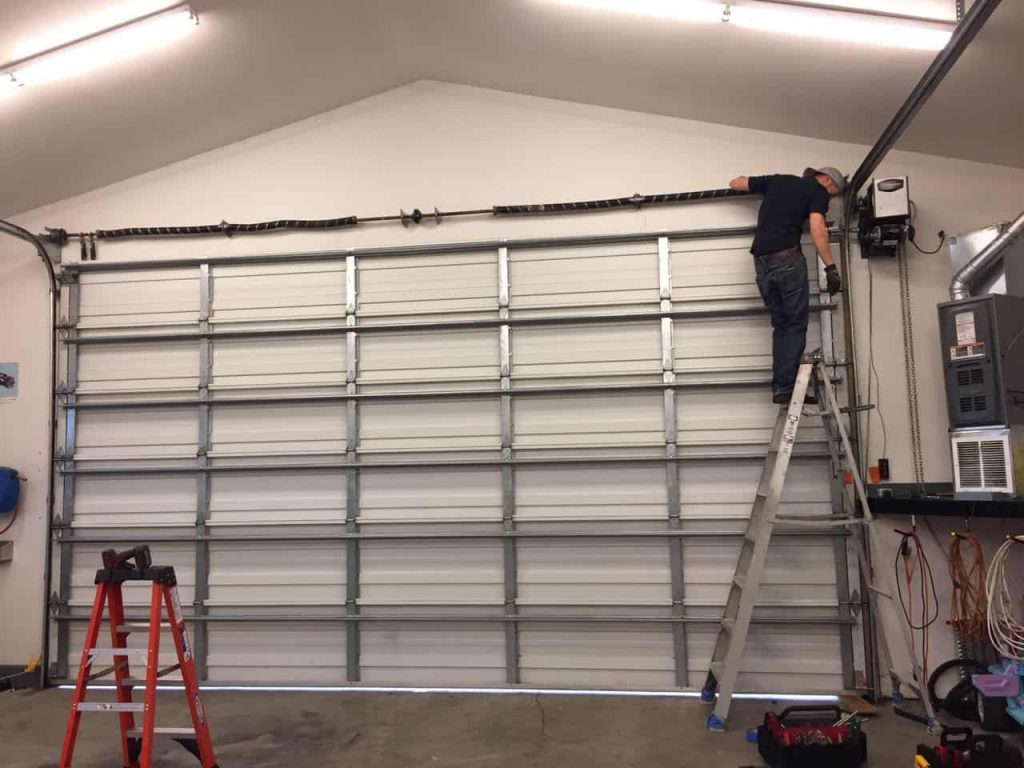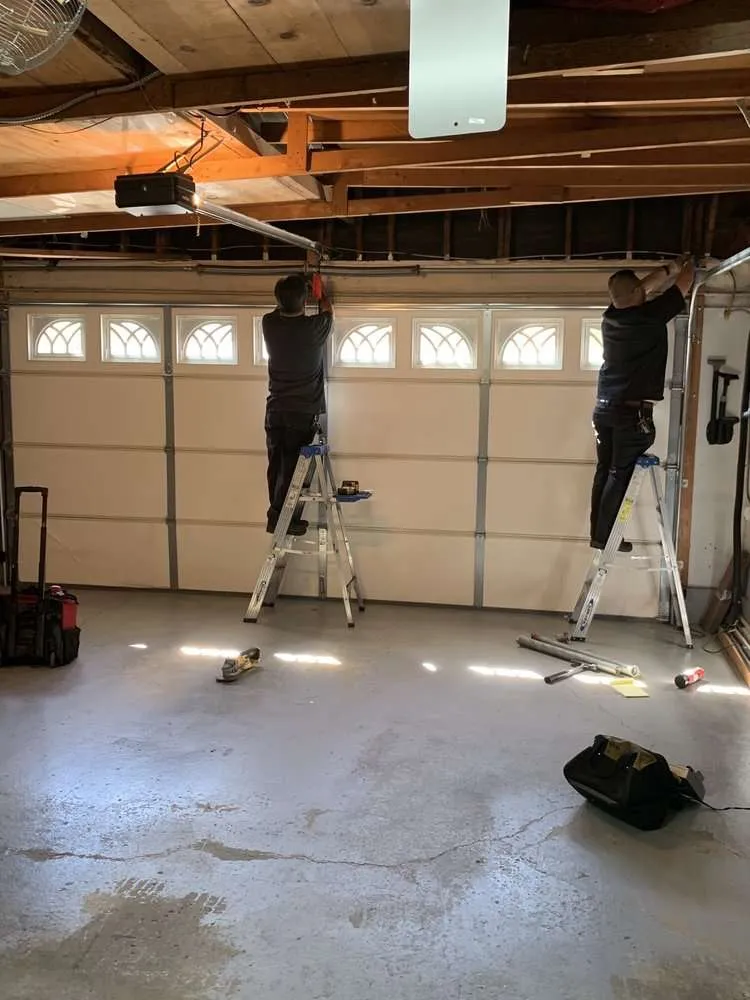Experienced Garage Door Repair for Damaged Tracks and More
Experienced Garage Door Repair for Damaged Tracks and More
Blog Article
Common Garage Door Issues and How to Repair Them
Garage doors are necessary for both safety and security and ease, yet they frequently provide a selection of common issues that can frustrate house owners. Troubles such as excessive sound throughout procedure, doors that fall short to open up or shut, misaligned tracks, and malfunctioning remotes can emerge without warning. While some problems might show up uncomplicated to deal with, others may need an extra nuanced understanding of garage door mechanics. Dealing with these problems efficiently not just enhances performance yet additionally lengthens the life of the door. One may question what actions are essential to tackle these difficulties successfully.
Noisy Garage Door Procedure
A noisy garage door procedure can be a considerable resource of nuisance for property owners, often indicating underlying mechanical concerns. Such interruptions might come from different reasons, including damaged rollers, loosened equipment, or insufficient lubrication. Recognizing the source of the sound is critical for efficient resolution.
One typical source of extreme noise is the visibility of rusty or damaged rollers. Over time, these components can weaken, causing grinding or squealing audios as the door actions. Routine inspection and replacement of these rollers can substantially decrease sound levels. In addition, loosened bolts or screws in the door device can produce rattling sounds throughout procedure. Tightening up these bolts ensures an extra secure and quieter movement.
An additional adding element is poor lubrication of the door's relocating parts. Using a top quality lubricant to the tracks, springtimes, and rollers can substantially reduce friction and noise. House owners should perform this upkeep occasionally to preserve ideal performance.
Finally, the garage door opener may likewise produce noise due to its age or mechanical concerns. If the noise lingers regardless of addressing various other elements, seeking advice from an expert for a complete examination and prospective repair may be essential.
Door Will Not Open or Shut
Experiencing a garage door that won't open or close can be unbelievably aggravating and frequently indicates a malfunction within the system. Numerous elements can add to this concern, and recognizing the origin reason is necessary for reliable resolution.

Following, check the safety sensing units situated at the base of the door. These sensing units can become misaligned or obstructed by particles, avoiding the door from operating appropriately. Clean the sensors with a soft fabric and guarantee they are lined up.
Additionally, the garage door's interior parts must be evaluated. Issues such as a busted springtime, worn-out rollers, or a damaged opener can hinder activity. If any type of elements appear to be damaged, it might be recommended to consult a professional for repair work.
Misaligned Tracks
(High-Quality Standards)Misaligned tracks can significantly interfere with the smooth procedure of a garage door, resulting in operational failures such as uneven motion or full immobilization. This concern typically develops because of a variety of factors, consisting of damage, accidental effects, or inappropriate installation. When the tracks are misaligned, the rollers can not move easily, which not only stresses the pop over here motor but likewise presents safety and security dangers.
If you discover any type of discrepancies, it is essential to deal with the issue immediately. Carefully tap the track back into its right position utilizing a rubber club or a similar tool, ensuring it is straight and degree.
Regular maintenance, including cleaning the tracks and making certain rollers are in good condition, can stop future misalignments. By resolving misaligned tracks without delay, you can recover the capability of your garage door and improve its longevity.
Broken Springs
Among the numerous components of a garage door system, broken springtimes are just one of the most typical concerns that can considerably hinder its performance. Garage door springtimes are crucial for stabilizing the weight of the door, enabling for smooth opening and closing. When a spring breaks, it can bring about a door that is challenging to run or, in many cases, entirely inoperable.
There are 2 major kinds of springtimes: torsion springtimes, which are installed over the door, and extension springs, discovered on either side. Signs of a broken springtime include a door that won't open, a noticeable space in the spring, or a loud sound during operation. Trying to operate a garage door with a busted spring can cause further damages to the door or the opener.
Fixing damaged springs is not a do it yourself project; it requires specialized tools and knowledge as a result of the high tension involved. It is advisable to get in touch with an expert service technician who can safely change the springs and ensure the door is correctly balanced. Regular maintenance and assessments can help prevent springtime failings and extend the life expectancy of the garage door system.
Remote Issues

The primary step is to inspect the batteries in the push-button control. Replace them if they are weak or dead. If the remote still stops working to run, evaluate the garage door opener to guarantee that its sensing units are clean and unblocked. Dust, debris, or misalignment might prevent the signal transmission between the remote and the opener.
Disturbance from other electronic tools can additionally hinder remote capability. Ensure that neighboring gadgets, such as wireless routers or cordless phones, are not creating disturbances. garage door service. If interference is presumed, attempt moving these tools further away from the garage door opener
Sometimes, the remote may need to be reprogrammed. Speak with the maker's standards to reset the push-button control and synchronize it with the garage door opener. If all else fails and the remote remains to malfunction, take into consideration speaking with a professional service technician for a thorough examination and prospective substitute of the remote or opener.
Verdict
(Effortless Experience)In summary, common garage door issues can considerably impact capability and security. Resolving noisy operation entails lubrication and tightening up equipment, while issues with opening or closing need inspection of power sources and sensors. Misaligned tracks can be remedied through adjustment, although damaged springs necessitate specialist treatment. Remote control malfunctions commonly arise from weak batteries or interference, which can be solved via substitute or reprogramming. Proactive upkeep and timely repairs can guarantee optimal performance and longevity of garage doors.
Report this page